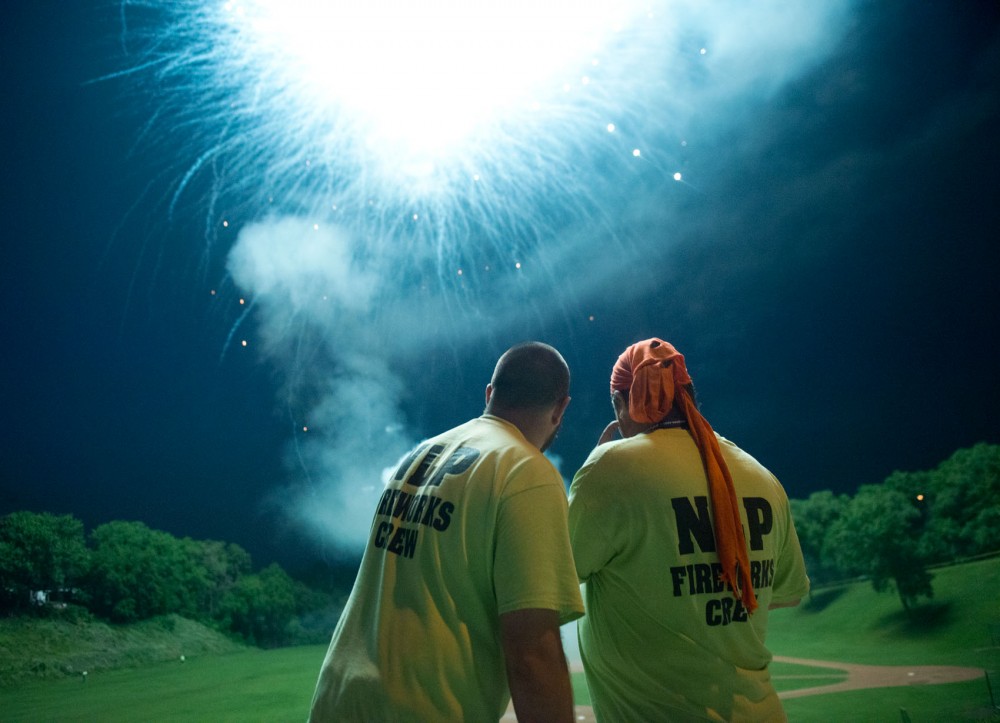In the midst of a rain storm Sunday, roughly 30 men and women in neon green T-shirts paused their work at Fred Lawshe Park as Marlyn Anderson shouted, “Fire in the hole!”
On cue, Paul Marchio fired a ground salute via remote control, prompting a loud bang and a cloud of smoke from a firework gun sitting in the field about 100 feet away.
Following the blast, which served as a wind check, the crew resumed preparing and placing dozens of firework shells among five tents.
The group of 30 is part of Northern Lighter Pyrotechnics, Inc., which has about 150 members. Founded in 1977, NLP is a nonprofit corporation that educates licensed members on the craft of building fireworks. This summer, the guild’s volunteers can be spotted at about 15 city festivals across the state, setting up, firing off and tearing down fireworks displays.
“We join [the group] for different reasons. Obviously, for the love of fireworks, but some people love setting up displays, and some love building,” member Joe Schroeder said.
Behind the scenes
For city display setups, NLP volunteers often arrive at 10 a.m. and leave at 2 a.m. the following day. At a typical setup, volunteers pair fireworks shells, place them in 2-foot-tall, high-density polyurethane tubes, called “guns,” and e-match them with an electric ignitor. At show time, licensed volunteers use a remote-controlled field module to fire off the shells.
“I love being out in the field, turning around looking at crowds of thousands of people,” Schroeder said. “Every artist loves people admiring their work.”
Following legal regulations, all of the work is completed in the presence of at least one NLP member with specific licensing, who serves as supervisor that day.
Public displays rarely show member-made fireworks because of legal limits. However, NLP members still can design the displays, choosing the layout and timing of the explosions. A designer can create special effects by selecting different ways to shoot the commercially made fireworks.
If members wish to build their own fireworks, they have to obtain licenses from the Bureau of Alcohol, Tobacco, Firearms and Explosives.
Pyro People
The only way NLP can showcase an all-member-made fireworks show while obeying legal limits is to hold an annual display exclusive to members, who call it their “Lake Shoot.”
NLP members bond at events like the Lake Shoot, social gatherings and display setups.
“These people are like our second family,” Anderson said.
Members also often attend the Pyrotechnics Guild International convention, a week-long annual event that entails competitions and workshops.
“For our family, that’s our vacation every year … Fireworks all week long. We build a big circle, we camp together, we cook together and hang out,” member Angela Marchio said.
A science and an art
Licensed builders learn more about manufacturing fireworks through occasional seminars from experienced members or at conventions like PGI.
“It’s all based on industry experience and information passed down from generation to generation,” Schroeder said.
The fireworks shells act as explosive Easter eggs. For a typical sparkling smiley in the sky, a builder first mixes chemicals with flash powders and leaves it to dry.
They cut the solid into tiny balls or cubes, called stars. Then they arrange the stars in the desired shape. Designers choose chemicals based on how they explode and which color they turn in the sky.
“Half of me needs to be a skilled craftsman to manufacture this firework, and the other half of me has to be an artist to create the fireworks you’re seeing,” member Tom Niesen said.
Despite the menial work of keeping track of legality — Angela Marchio said her house fills with paperwork this time of year — and through the labor-intensive process of making a display, members shared laughs and stories while setting up Sunday.
“[Paul, club president and Angela’s husband] obsesses and wants everybody to be happy. He wants the crews to be happy and the crowd,” Angela Marchio said. “It’s mostly just about making people happy.”
A lifetime fascination
Once members find their way to NLP, they don’t often leave. Whether a builder or not, the shared passion for fireworks keeps people coming year after year.
“There’s a quote that says, ‘Once you’ve smelled the smoke, you’re never again the same.’ That’s what keeps bringing you back every year,” member Gregory Glavan said.
For some, NLP opened a way to act on a longtime interest in pyrotechnics.
Niesen said he had always loved fireworks and joined NLP after reading about it in a newspaper article about 20 years ago.
“The club [is] our creative outlet,” Niesen, who holds a license to build shells, said.
Schroeder joined NLP with his father, Bob Schroeder.
“He walked up to me at age 15 and asked if we could make flash [powder],” Bob Schroeder said of his son, Joe Schroeder. “That’s how we got in. My son was so interested.”
Paul Marchio, longtime president of the club, joined NLP with his wife, Angela Marchio, in 1997.
“I just watched a show real close one time and never turned back, basically,” Paul Marchio said. “I felt the thump and smelled the smoke.”
Prospective members must pass a background check and complete a phone interview, which screens for ill motives.
Once accepted, members receive both lecture-style and hands-on training. For their first year, members wear an orange T-shirt at display setups to signal that they are still learning.
To maintain membership, NLP members must attend an educational experience related to building fireworks or setting up shows at least every two years.
“We’re always looking for new members, and we’re always looking to train members. It’s all about safe use of fireworks,” Niesen said.








